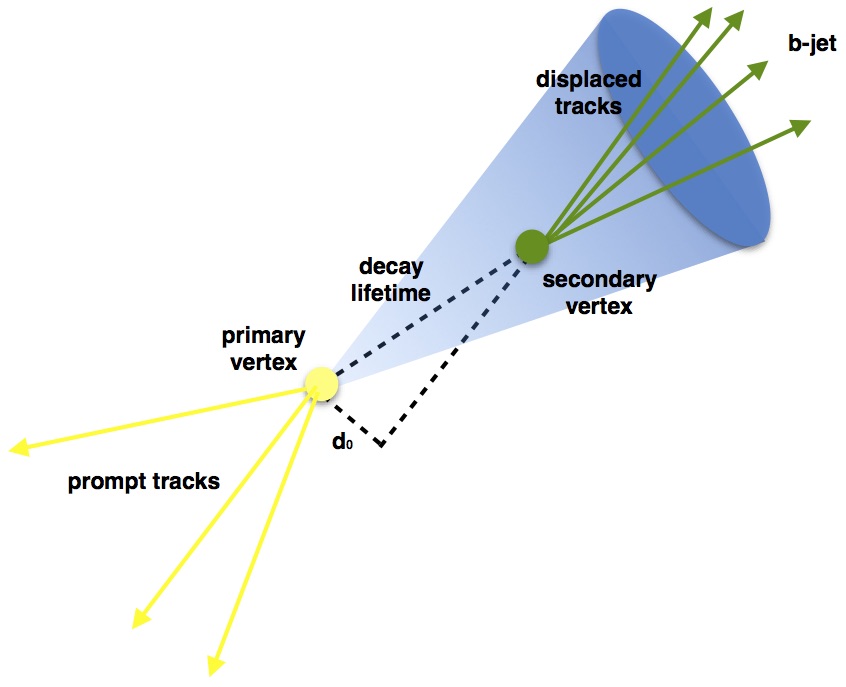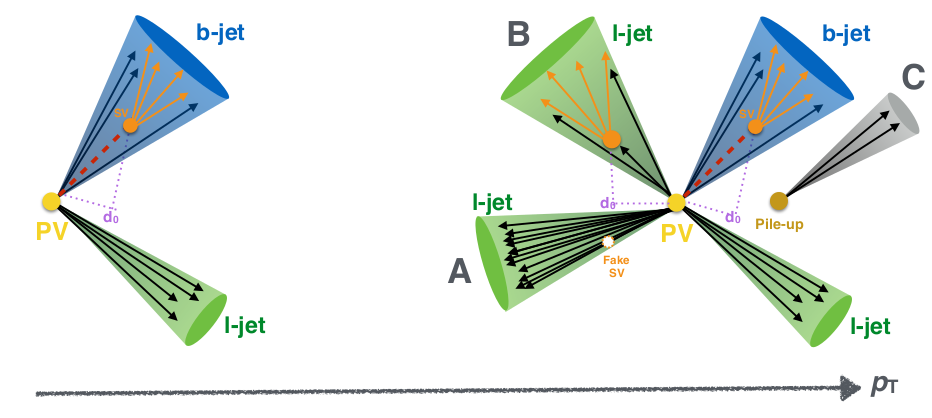ATLAS Flavor Tagging
The identification of jets containing particles originating from the hadronisation of a heavy-flavor quark, a b-quark or a c-quark, is a key ingredient to many fundamental measurements and searches in the ATLAS experiment, including Standard Model precision measurements, Higgs boson property measurements, and searches for new physics. This applies in particular to the ATLAS analyses carried out in the Siegen group, as the separation of the signal from the background events in top physics crucially relies on the reconstruction of b-jets.
The ATLAS Collaboration uses various algorithms to identify b-jets, which are referred to as b-tagging algorithms. These algorithms exploit the long lifetime, high mass and high number of particles produced in its decay, as well as the properties of the b-quark fragmentation. Since the B-hadrons have relatively long lifetimes, of the order of 1.5 ps, these can have significant mean flight lengths $\braket{l}=\beta \gamma c \tau$ of several millimeters before decaying in the detector. Therefore, the reconstruction of a secondary vertex, which is displaced compared to the vertex from the hard-scattering collision point, is often possible.

Our group is working on the Secondary Vertex Finder (SVF) algorithm, which reconstructs these displaced b- and c-hadron decay vertices inside a jet. The obtained list of secondary vertices in a jet and their properties are then propagated to the b-tagging algorithms. To identify the displaced vertices, first all possible two-track vertices are reconstructed. Significant numbers of secondary vertices are produced by interactions of primary hadrons with detector material, photon conversions and decays of long-lived particles ($K_s$ and $\Lambda$). These are real vertices, but they constitute a significant background to the decays of b- and c-hadrons. Their number has to be reduced in the b-jet identification process, which can be achieved with kinematical and geometrical cuts on the two-track-vertices. Multi-track vertices are then built out of the remaining two-track vertices by merging those which are close in space.
Another active field of research is the Track Classification Tool (TCT), which assigns a probability to each individual track to stem either from B-hadron decay, fragmentation or other categories, such as pile-up and material interactions. This is achieved through a multivariate analysis taking as input the kinematical and geometrical track parameters. Based on this classification, a new b-tagging algorithm, the Classified Track Tagger (CTT) is being developed. This is in particular interesting in the region of large transverse momenta of the jets, since the higher fragmentation track multiplicity in this energy region is one reason, why the performance of established b-tagging algorithms diminishes. Selecting only tracks with high probability to originate from a B-hadron decay could mitigate the problem of increased fragmentation multiplicity.

Publications (with contributions from this group):
- ATLAS Collaboration, ATLAS b-jet identification performance and efficiency measurement with $t\bar{t}$ events in $pp$ collisions at $\sqrt{s}=13\,$TeV, Eur. Phys. J. C79 (2019) 970
- ATLAS Collaboration, Optimisation and performance studies of the ATLAS b-tagging algorithms for the 2017–18 LHC run, ATLAS-PHYS-PUB-2017-013
- ATLAS Collaboration, Secondary vertex finding for jet flavour identification with the ATLAS detector, ATLAS-PHYS-PUB-2017-011
- ATLAS Collaboration, Optimisation of the ATLAS b-tagging performance for the 2016 LHC Run, ATLAS-PHYS-PUB-2016-012
- ATLAS Collaboration, Performance of b-Jet Identification in the ATLAS Experiment, JINST11(2016) P04008





